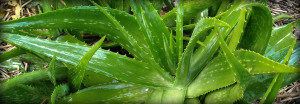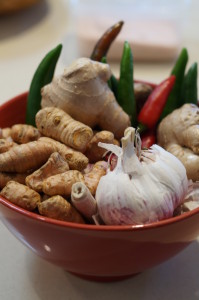Here is an alphabetical list of amazing healing plants and herbs. You can grow a selection, from Aloe Vera to thyme in your garden and pick when needed.
Aloe Vera – remarkable all healing, undemanding plant

The Aloe Vera plant grows in a clump and has plump, fleshy, thorn-edged leaves. Aloe Vera is not harvested like other herbs. You cut the leaves only when they are needed. Otherwise, you leave the plant intact. The clear gel from inside the leaves is soothing and moisturising and widely used for burns, cuts and open wounds. Among the benefits of using aloes is that they have anti-inflammatory and antifungal properties, have an inhibitory effect on cancer and are anti-ageing.
How to use
The gel can be used in smoothies, but the aloe skin needs to be removed with care, so no bitter leaf remains in the gel cubes. Medicinal uses are many. Fresh or commercially preserved Aloe Vera juice can be used both externally and internally. In capsule form, it is used as a natural laxative and is used commonly for irritable bowel syndrome.
Gel squeezed from a freshly picked leaf can be used like tooth paste. Seal the cut leaf with cling wrap after use and leave in the fridge till you need it again.
Aloe is effective for healing burns, scars, and skin rashes. In tablet form, this herb has been known to combat kidney infections and can help relieve arthritis and ulcers. It is used in cosmetics, including in anti-wrinkle creams and make up. See aloe article for burns and watch video for more information.
Basil – The sacred herb associated with love and fear.
Basil is a member of the mint family and, like most other mints, is mainly used in medicine for its digestive and anti-gas properties. Basil can be taken for mental fatigue and nervous stress. Herbalists also recommend it for stomach cramps, vomiting, constipation, headaches, and anxiety.
How to use
Basil is usually made into a tea for medicinal purposes. Try a cup of tea after dinner to aid your digestive process, but not if you have trouble sleeping as it stimulates and addresses mental fatigue. Sprigs of basil and peppermint can be combined and used to make a tea, which is a great pick me up. You can keep topping the pot up as the infusing continues for 4-6 cups of tea. Steep basil leaves in wine for 2 days. Take a tablespoon in a glass of water and sip slowly. Combine this with hyssop and honey for a cough. An inhalation can be used for colds and hay fever. Rub fresh leaves on insect bites to stop the itching. Add a bunch of basil leaves to your bath lift. Use the steam to treat acne.
Chamomile – calms and soothes the skin
Chamomile contains anti-inflammatory azulene which reduces redness on the skin. Its anti-infective properties mean it can be used to treat many common ailments, while it is also an antispasmodic, used for such problems as stomach cramps and indigestion. Chamomile flowers are used internally for many common physical symptoms, including menstrual cramps, stomach cramps, indigestion, flatulence, diarrhoea, fever, colds, congestion, headaches, insomnia, nausea, vomiting, stress, nervousness, and poor digestion. For babies, it is helpful with symptoms of colic and teething pain.
How to use
For external use, chamomile flowers can be ground into a paste and used to treat skin irritations such as ulcers, infections, rashes, and burns. . (Grind up with a mortar and pestle. Then add some water or unsweetened tea and a little oatmeal as needed for consistency.)
The flowers can also be used in a bath to ease the pain of haemorrhoids and cystitis, and the essential oil can be applied to combat neuralgia and eczema. Use a handful of chamomile flowers in a mesh bag for your bath. Hang the bag on the tap using string and run the bath water over the flowers. Use as a rinse on brown hair to create golden highlights. Use as a tea for above problems. Chamomile combined with very cold milk calms irritated skin, restricts blood vessels and reduces puffiness.
Dill – soothes colic in babies
Dill means “to lull”, which explains the calcium-rich herb’s traditional use: to soothe and relieve. It’s known to treat insomnia and also has strong antibacterial properties. Dill aids indigestion, combats wind and promotes breast milk production for nursing mothers.
How to use it
Use as a seasoning, or pour hot water over the leaves for a herbal tea. Chewing the seeds helps to eliminate bad breath. Seeds can be used in a salt-free diet as a rich mineral salt. (Grind 13g of seeds before infusing in 225ml water. Drink three cups of this brew per day.)
Garlic – broad spectrum infection fighter

Garlic bulbs are viewed as a wonder drug with a reputation in folklore for preventing everything from the common cold and flu to the plague. Garlic is known to strengthen the blood vessels. It has antibiotic, anti-fungal, antiviral and anti-parasitic properties. Adding garlic to your diet is also known to lower blood pressure and suppress cholesterol production in the liver. It is known to boost the immune system.
How to use
Garlic is most beneficial eaten raw (or applied to the skin), as some of the healing properties become lost during the cooking process. The cloves can be swallowed whole. To gain the best therapeutic value when cooking with garlic, I suggest add the crushed garlic only at the end of the cooking process. Stir it in just before you serve. This gives maximum flavor and retains all garlic’s nutritional value.
Garlic has irritant factors which increase the longer you cook it and the higher the temperature. It is high in fructans which some people cannot digest. It contributes to irritable bowel syndrome (IBS). However, even those on the FODMAPs diet, can still cook with garlic flavoured oil, that has been infused for up to two minutes with a single garlic clove. This is because fructans are not soluble in oil.
Ginger – a spicy anti-inflammatory
Praised by Confucius and used in recipes by Nostradamus, ginger has been revered as the ‘universal medicine’ for thousands of years. Today, it remains a remedy for arthritis, nausea, indigestion, fever and infection. It has qualities that may prevent heart attacks; reduces hypertension; aid digestion; prevent colds and flu and aid weight loss. It also promotes lung function, strengthens adrenal glands (often depleted by stress), relieves morning sickness and menstrual cramps and can help reduce wind.
How to use
For ginger tea, infuse grated ginger root to cleanse the body. Use two slices of fresh ginger to one cup of boiling water. Take three times a day. Add lemon and honey to taste to warm the body on cold days. Chew the root or gargle for a sore throat. Do not brew as it increases the irritant factor. Drink ginger tea for travel sickness. Make a ginger paste with fresh ginger and water, apply to the forehead for headaches and migraines. This paste can be used for rheumatic pains by applying a poultice. Add four teaspoons to the bath water to relieve sore muscles.
Lavender – oil takes the sting out of insect bites
This shrubby herb is largely cultivated for its essential oils, which calm the nerves, soothe headaches, ease dizziness and help relieve depression and stress. It is an excellent remedy for burns and stings and its strong anti-bacterial action helps to heal cuts.
How to use
Smell a fresh bunch or take internally — lavender’s antibacterial and antiviral properties help dispel harmful bacteria and other micro-organisms in the intestines. Alternately, use as massage or bath oil, a household cleaner, insect repellent and even a mouthwash. It can be made into a tea, or flowers can be added to honey and used as a spread.
Mint – there are so many flavors and fragrances to enjoy!
Well-known for its ability to sooth the digestive tract and reduce the severity and length of stomach aches, mint can also ease the symptoms of IBS and slow the growth of harmful bacteria and fungi.
How to use
Grow your own. It is one of the easiest herbs to grow. Use fresh infusion for herbal tea. Sip cold tea for wind and hiccups. Macerate the leaves in oil then massage affected areas for headache, facial neuralgia, rheumatic and muscular aches and pains.
Oregano – Greeks called it ‘Brightness of the mountain’
Beloved in culinary circles for its strong, warm, aromatic taste, oregano also has antimicrobial, antiparasitic and strong antibacterial properties. It enhances immune function, perhaps due to the volatile oils that the herb contains. Oregano is a powerful source of anti-oxidant vitamins. The tea has a tranquilising effect on nerves and helps settle upset stomachs.
How to use
Use in cooking or for brewing a herbal tea. Fill a mesh bag with fresh oregano leaves and toss it into a hot bath. You’ll enjoy the delightful aroma, and may find it easing your aches and stiff joints.
Parsley – the chef’s everyday garnish
Apart from sweetening your breath, this common meal garnish can help eliminate toxins in the liver, treat allergies, asthma and bladder infections. It is also a diuretic, reduces oedema (fluid retention), indigestion and wind. The herb has anti-parasitic properties and promotes healthy thyroid function. The leaves are a rich source of vitamins including Vitamin C
How to use
Eat raw or use in salads, sauces, casseroles etc. with gay abandon.
Rosemary – universally grown and loved herb
Rosemary aids strong hair growth and is also a very versatile hair care herb for people with dark hair. It restores lustre, revitalises the hair and stimulates hair growth. It is also one of the best remedies for dandruff. As a tonic and stimulant, rosemary enhances memory function, protects the brain from free radical damage and combats fluid retention.
How to use
Can be made into a herbal tea which can either be drunk or used as a hair rinse for dark hair. For a pleasantly aromatic infusion to settle the stomach or clear a stuffy nose, simply steep 1 to 2 teaspoons freshly bruised rosemary leaves in a cup of boiling water for 10 to 15 minutes. Drink three cups a day.
Sage –’He who would live with aye, must eat sage in May’
The old English proverb points to the positive qualities of sage. This herb is not just used for savoury turkey stuffing. It aids in mental clarity and circulation and also has antimicrobial and anti-inflammatory properties. It is an effective gargle for sore throats and mouth ulcers and is known to ease the digestion of fatty foods. Sage is commonly used to combat hot flushes.
How to use
The leaves are best used before the plant comes into flower. For tea; use 2 teaspoons of fresh leaves and steep for 8 to 10 minutes before drinking. Rub leaves directly over stings or bites as a first-aid remedy.
Thyme – nature’s best antiseptic
Take it in tea-form to help heal sore throats, coughs, bronchitis and laryngitis. It is antiparasitic and relieves muscle pain and tightness.
How to use
Brew tea by steeping 2 teaspoons of fresh thyme leaves or a small bunch in hot water. Drink one cup of thyme tea three times a day. A gargle can be made from the essential oil (use no more than 2 drops in a glass of water).
Caution
For safe and appropriate medicinal use of herbs please consult your doctor or health care practitioner. Do not use the above herbs internally in greater than culinary quantities if you are pregnant or breast feeding.
“Never forget to be grateful – it is a beautiful quality. Grateful for any little tiny act that any one has ever done for you or will do for you in the future be thankful for all, all, all that is done for you”
Rajneesh